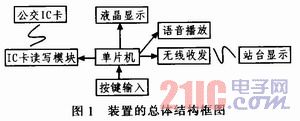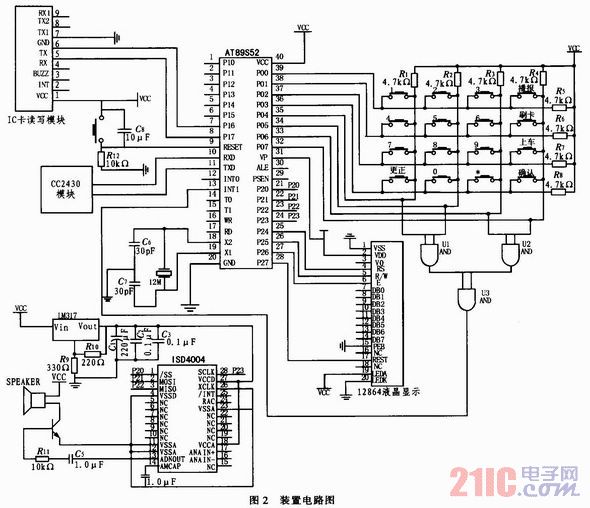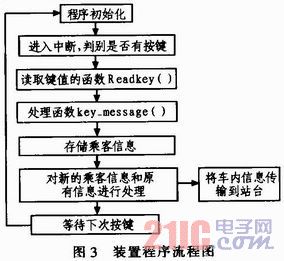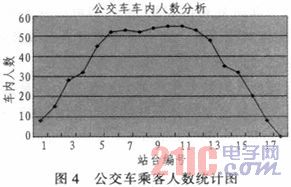Abstract: A hand-held bus fare and information statistics device is proposed, which is charged according to the distance traveled by passengers, instead of the traditional segmented charge. At the same time, the number of passengers on each station can be counted, and the number of people getting off at each station and At present, the number of people in the car, etc.; then the wireless data transmission module can also send the information on the car to the passengers on the platform for reference, and the device can also read and write for the existing bus card, providing the citizens with green travel. convenient. Such a device can store and summarize the passenger flow information on the bus, analyze the information of the traffic flow and the flow of people, and facilitate the bus company to perform scheduling and statistics.
Keywords: charging; information statistics; bus; transportation; passengers
At present, traffic congestion in cities is more serious. According to relevant news reports: In China, traffic congestion has spread from megacities such as Beijing, Shanghai and Guangzhou to some large and medium-sized cities: from the “point†congestion inside the city, it has expanded into partial “face†congestion. In the morning and evening peaks of residents' travel, the congestion phenomenon is more obvious, and the urban roads are obviously saturated. According to the statistics of relevant departments, the economic losses caused by the inconvenience of urban transportation in China can reach hundreds of billions of yuan every year. All countries in the world attach great importance to the role of public transport development in solving urban traffic congestion problems. The principle of public transport priority has also become the consensus of the management departments of various cities in China.
However, under the same service level, the per capita dynamic occupancy of public transportation has a relatively small road surface, which can greatly save road resources. The per capita dynamic footprint of buses, bicycles, and non-bus vehicles is 1:4:12. At present, in China's urban public transportation system, buses and trams bear more than 80% of the passenger traffic in the city. For urban travel, the cost of passenger buses is much lower than that of non-buses. Therefore, the long-distance travel in the city, the total cost of public transport is the lowest. The flow of people, logistics and motor vehicles in China is increasing sharply, exposing the problems of urban traffic.
The bus fare collection and information statistics device proposed in the paper can charge different charges for passengers on different distances, and can also collect, store and transmit information inside the vehicle.
1 System function description In this paper, a new charging device is designed to provide a handheld bus charging and information counting device for the defects of the prior art. The functions of the device mainly include: 1) Using Zigbee technology to transmit the number of people in the car and the location information to the station for display. 2) Using voice technology to display the number of stations and LCD screens to remind the number of people arriving at each station. 3) Using arrays to store information on passenger flow statistics, which is useful for analyzing passenger flow characteristics and facilitating bus scheduling and route planning. 4) Automatically count the ticket sales amount to provide convenience for account management after bus operation.
The handheld bus charging and information counting device mainly includes a wireless transceiver module, a voice broadcast module, a liquid crystal display module, a non-contact IC card reading and writing module, a microprocessor and a keyboard input module. Its structural block diagram is shown in Figure 1.
This article refers to the address: http://

The structure functions are as follows:
1) The wireless module wireless module mainly sends the information in the car to the passengers on the platform, which allows the passenger to know the information in the car in advance and better select the travel route; thus avoiding the inconvenience caused by some cars being overcrowded.
2) The voice module is mainly used to remind passengers and flight attendants to arrive at the station information, so that passengers can prepare for getting off the bus.
3) The LCD module reminds us that it will arrive at the station, displaying passenger and vehicle information, and providing a good man-machine exchange interface.
4) The non-contact IC card reading and writing module integrates the functions of the original bus card, and can read and write the bus card to facilitate the passengers who hold the card.
5) The core module of the MCU module device is used to process various data, process various types of information, and connect the various modules of the device to make the whole device work well.
6) The input module enters the passenger's information and provides a channel for man-machine exchange.
2 system hardware design This kind of handheld bus charging and information statistics device is mainly used in long-distance bus with ticket sales, including non-contact IC card reading and writing module, wireless transceiver module, liquid crystal display module, keyboard input, voice Broadcast and microprocessor. In this paper, each device module uses serial port to connect and communicate. The hardware module connection circuit diagram of this device is shown in Figure 2.

The IC card reading and writing module uses the RF card reading and writing module, the model is wm_17tc, reads and writes 8 k and 32 k mifare cards, uses ARM processor, fast reading and writing speed, good read and write stability, card upload card number, no round Inquiry, simple programming, full development materials, online technical support, large usage, is the best choice for microcontroller development.
The wireless transceiver module uses the CC2430 chip to achieve the required functions. The CC2430/CC2431 are fabricated in a 0.18μm CMOS process with current losses below 27 mA or 25 mA in receive and transmit modes, respectively. The CC2430/CC2431's sleep mode and ultra-short-time transition to active mode are ideal for applications that require very long battery life.
The model of the liquid crystal display module is HG1286419. The color of the chip is monochrome. The screen size of the LCM LCD module is 3 inches. The contrast of the STN yellow-green mode is adjustable. The resolution is 128x64 and the dot pitch is 0.40x0.40 (mm). The time is 500 ms, the viewing angle is 50°, and the display size is 60.0x32.6 mm2. Point size: Single 5 V/single 3.3 V can be used.
The voice broadcast uses the ISD4004 chip; the chip operates at 3 V and the recording and playback time is 8 to 16 min. The chip uses CMOS technology and includes an oscillator, anti-aliasing filter, automatic squelch and high-density multi-level flash memory display. The sampling frequency can be 4.0, 5.3, 6.4, 8.0 kHz. The lower the frequency, the longer the recording and playback time, and the sound quality is reduced. The on-chip information is stored in the flash memory. In the case of power failure, it is stored for 100 years and repeated recordings are 100,000 times.
The microprocessor uses ATMEL's AT89S52 microcontroller, which is a low-power, high-performance CMOS 8-bit microcontroller. Has 8 kΩ in system programmable flash memory. Manufactured using ATMEL's non-volatile memory technology, it is fully compatible with industrial 80C51 product instructions and pins. On-chip Flash allows the memory to be programmable in the system and also for conventional programmers. The AT89S52 has the following standard functions: 8 kbytes of Flash, 256 bytes of RAM, 32-bit I/O lines, timers, 2 data pointers, 3 16-bit timer/counters, and a 6-vector 2-level interrupt structure. , full-duplex serial port, on-chip crystal oscillator and clock circuit.
The keyboard of such a device is set to a 4x4 matrix keyboard, which is numeric keys 0-9, correction, confirmation, multiplication, swiping, broadcast, and transmission. The function settings of each key are as follows: number keys 0 to 9 are used as station input and number of people input, and clear key is to clear the record of the last key input. The confirmation key is the confirmation after entering the number of stations and the number of people. After pressing the confirmation key, the specific amount can be displayed on the LCD. The multiplication key is an identification key between the input station and the input number. After pressing the number of stations, press the multiplication key, and then by the number of people, it means that several people get off at the platform of the above number of stations. The function of the card key is to deduct a specific amount from the IC card by using the read/write module of the non-contact type IC card of the device after obtaining the amount of money, thereby realizing reading and writing of the bus card. The function of the broadcast is to broadcast the platform and the number of people who need to get off. Press "Digital + Send" to indicate the number of people on the platform, which is the number of people who need to charge the ticket seller. At the same time, when the "send" button is pressed, the wireless data transceiver module is triggered to send data to the station.
3 system software design The system software program mainly includes keyboard input software system, single chip processing system, wireless transceiver software system. The keyboard input system transmits the information to the single-chip processing system through the information collection, and the single-chip computer processes the data to reflect the required information in the liquid crystal display module and the voice broadcast module. At the same time, the information input by the keyboard is processed, and the useful information is transmitted to the station through wireless transmission, and the station can transmit the information to the next station through the received information. In this way, the information of the whole bus operation process can be statistically calculated, so that the bus company can reasonably dispatch the bus.
The entire program is written in C language, the main program process is shown in Figure 3.

Such a device also has a function of long-term statistical interval passenger flow. According to the number of stations per passenger and the number of stations in the next station, the passenger's boarding interval information is accumulated and recorded in the device.
This device mainly relies on the keyboard module to input information. The software program of the keyboard module is as follows: 

The following is the data statistics for a bus trip as shown in Figure 4 and Table 1.


Table 1 can clearly understand the situation of the car during the driving process of the bus. The bus passengers have the largest number of stations in the middle, and the number of people getting on and off is also in the middle. The information is output to the computer for analysis through the interface, and the long-term passenger travel interval statistics are helpful for bus dispatching and bus route planning. At the same time, data collection on the number of passengers on the bus and the status of the bus can be analyzed, and the number of passengers on each platform can be analyzed to understand the needs of each platform. Using the records and statistics of these data, through nonlinear algorithm analysis, it is even possible to analyze the road conditions, the degree of congestion and whether there is a traffic accident on a certain day.
4 Conclusion This hand-held bus tolling device greatly optimizes the unreasonableness of the current charging method, and provides great convenience for passengers, especially those who travel at close range. At the same time, the statistics and feedback on the information in the car have a good reminder and forecast for the passengers on the bus stop. The bus department can also analyze and process the data reasonably.
I-Pulse Feeder , original and new or used one, in stock, high quality.
Material: Stainless steel
Feeder can be divided into tape feeder, tube feeder, tray feeder or stick feeder.
Feeder can be divided into original feeder and replacement feeder.
All the feeders shall be maintained during the use time
In addition, the following spare parts will be sold in our company.
Samsung Feeder
Panasonic SMT Feeder
Panasonic Feeder
Smt Machine Panasonic Feeder
Smt Feeder For Panasonic
JUKI Feeder
I-pulse Feeder
I-Pulse Feeder
I-Pulse Feeder,Smt I-Pulse Feeder,Smt Parts I-Pulse Feeder,I-Pulse Type Feeder
Shenzhen Srisung Technology Co.,Limited , https://www.sr-smt.com